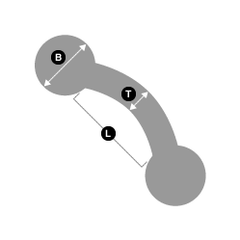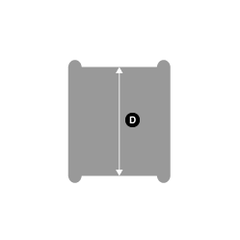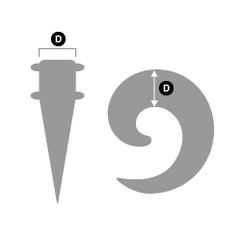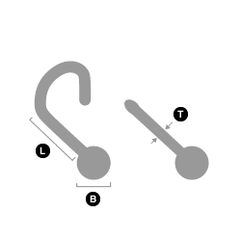How to Measure Body Jewelry
THICKNESS / GAUGE
The word gauge (pronounced GAYj) refers to the thickness of body jewelry. Gauge sizes work in reverse, meaning that higher numbers (like 16 gauge) are thinner than smaller numbers (like a 6 gauge). Body jewelry gauges usually range from 18 to 00g - after 00g, jewelry then goes to actual measurements such as with 1/2 inch plugs. The word gaging refers to increasing the size of a piercing hole to accommodate larger jewelry.
If you need to know what gauge your own piercing jewelry is, the best thing to do is go back and ask your piercer. Unless you request something different, most piercers have a standard size they prefer to use for starter jewelry. Most starter piercings are usually either 14 or 16 gauge, although some may go as large as 12 or as small as 18. Choosing the right gauge is always important.
We carry jewelry in almost every gauge, so you're sure to find the perfect fit.
DIAMETER
Diameter is a type of measurement used for circles or other round objects. In the piercing industry, diameter measurement is used to determine the size of the ring used in piercings, to ensure that the correct size is worn. CBR (Captive Bead Rings), Horseshoes and Other Circular Style body jewelry has a diameter measurement. This refers to the distance across the ring at its widest point and is measured in the inside of the ring. It is not an overall diameter; it is the internal diameter of the ring.
The internal diameter is important when buying ball closure rings, circular barbells and body spirals because it tells you how much space there will be for your piercing. This is especially important where the ring goes around part of the body, such as a lip piercing or a helix piercing. To find out the best internal diameter you should measure from the piercing hole to the edge of your lip / ear / nose.
LENGTH
The length measurement refers to the length of the jewelry bar. Not the length of the whole product. The length of the barbell is measured as the distance between the two balls at either end. It is always important to get the right length piercing jewelry! If the piercing jewelry is too short it will pinch and may reject, whereas overly-long piercing bars will slide and be uncomfortable.
T (Thickness), D (Diameter), L (Length), B (Ball Diameter)











IF YOU HAVE ANY QUESTIONS REGARDING SIZES OR OUR PRODUCTS, PLEASE CONTACT US.
